City guides


The Highlands Travel Guide
The Highlands of Scotland contain some of the most spectacular scenery in the world. A timeless wonderland, where roads and railways cut through breath-taking mountain landscapes, past deep and mysterious lochs, through the world's finest whisky-producing regions, and up to the highest peaks in Britain. The Highlands are suffused with the romance and grit of the clans, and nowhere in the country is it clearer that the Scottish have a proud, ancient culture, independent of the rest of the United Kingdom.
The city of Inverness is the gateway to the Scottish Highlands. It is a very attractive place, built alongside the River Ness, which has a rich history palpable in its ruins, museums and the important battle sites just outside the city. It is the northernmost city in the UK and a delightful travel base for visitors hoping to explore the north of Scotland.
The deep and dramatic Loch Ness, a short journey from Inverness, is the legendary home of the mythical Loch Ness Monster and attracts thousands of visitors every year, all eager to catch a glimpse of 'Nessie' or just enjoy the stunning scenery around the loch. Off the coast, the Hebrides, Orkney and Shetland Islands with their rugged and dramatic scenery, reveal ancient settlements and unspoilt insights into the ancient history of Scotland. A visit to this highland wilderness, despite predictably unpredictable weather, ignites a very basic pleasure and can be a glorious and refreshing experience. The Highlands are a haven for hikers, with some superb, remote walking trails.
Things to do in The Highlands
The Highlands are home to Ben Nevis - the highest mountain in Britain, the mysterious Loch Ness, some fascinating historic battlefields and the hauntingly beautiful Isle of Skye. The common theme of almost all the main attractions in the north of Scotland is the breath-taking natural scenery, which is primarily what lures visitors from all over the world to this sparsely populated, wild and rugged region of the UK. Even the genuinely interesting history and culture of the Scottish clans seems to be part of the Highland landscapes; each battle, betrayal and stronghold made romantic and meaningful by the beauty that forms its backdrop. The top attractions of the Highlands are therefore the walking trails, mountain tracks, coastal paths and railway routes which traverse the lovely region, allowing travellers to fully experience the open, majestic scenery which has enchanted so many already.
Inverness and Fort William both make convenient travel bases in the Highlands, and the many old fishing villages along the coast can fill a holiday by themselves. The rugged coastline of northern Scotland is worth exploring by boat, car or on foot, and the many islands scattered along the coast are alluring and mysterious, often containing ancient ruins and featuring in local folklore.
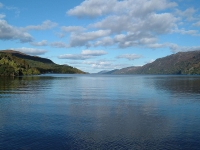
Loch Ness
Loch Ness is situated in the Great Glen that links Inverness on the east coast to Fort William in the west. The most famous lake is 24 miles (39km) long, half a mile (1km) wide and 700ft (213m) deep and is home to the legendary Loch Ness Monster (affectionately called Nessie), which many claim to have glimpsed from the shore, despite the ongoing scepticism of scientists. There are fine walks around the mountains and glens that surround the loch and many head for the scenic ruins of Urquhart Castle or the Nessie exhibition at Drumnadrochit.
The four lochs that make up the Great Glen are linked by the Caledonian Canal, which was built in the early 1800s to enable ships to pass from the North Sea to the Atlantic without having to navigate Scotland's harsh north coast. The most traditional and comfortable way to travel along the glen is by boat, and a flotilla of canoes, yachts and cruising boats are available for hire in Inverness and Fort William. The more energetic may opt to walk or cycle along the 70-mile (113km) Great Glen Way. The walk will take four to seven days. Whether for the enticing mystery of the monster or the stunning natural beauty of the area, travellers relish a visit to Loch Ness.
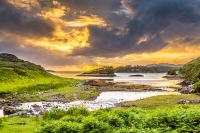
Northern Highlands
Beyond Inverness and the Great Glen, Scotland stretches away in a spectacular fusion of wooded glens, sweeping moors, rugged coasts, towering mountains and welcoming villages. The Northern Highlands includes both the rich farmland of the Black Isle and the precipitous sea cliffs of Cape Wrath. The traditional crofting communities of North West Sutherland, the busy towns of Easter Ross, the historic fishing villages of Caithness, the wooded hills of Mid Ross, the popular beaches of East Sutherland and the majestic mountains of Wester Ross are all contained in the Northern Highlands.
Due to its remoteness, this huge area is largely overlooked by tourists despite having some of the most dramatic landscapes in all of Europe. The Northern Highlands are a paradise for those seeking out solitude and active outdoor pursuits in breath-taking landscapes. There are ancient archaeological sites and a number of quality heritage centres around Caithness and along the northern coast, dealing with the rich clan history and Viking heritage of the region. The Northern Highlands seem designed for walkers and hikers and the patchwork of beautiful lochs in the northwest attract fishermen. Golf, cycling and water-sports are also popular activities, with a number of great boat trips exploring the rugged coastline.
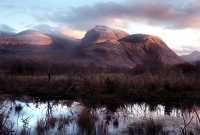
Ben Nevis
The highest peak on the British Isles, Ben Nevis, affectionately known as 'The Ben' among locals, is an extremely popular destination for serious mountaineers and intrepid hikers alike. Located near the charming town of Fort William in the Scottish Highlands, the imposing igneous cliffs of Ben Nevis dominate the skyline and offer an irresistible challenge to active types looking to conquer Britain's most intimidating climb. The cliffs of the mountain are ideal for climbers and are also one of the UK's best ice climbing sites. There are two main routes up the mountain: the Mountain Track, which is geared for experienced climbers, and features a thrilling ascent up craggy 700 metre (2,300 feet) cliffs on the mountain's north face; and the gentler Glen Nevis route, which is suited to fit hikers, and follows a steep track up the mountain's south face. On the summit of Ben Nevis, the ruins of an old observatory (abandoned since 1904) can be found, and the views are immense, rugged and spectacular. At the foot of the mountain, the famous and popular Ben Nevis Distillery can be found near Victoria Bridge (a little ways north of Fort William), providing an interesting excursion for malt whisky enthusiasts.
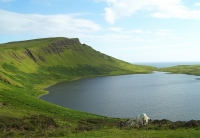
Isle of Skye
Linked to the mainland by the Skye Bridge in 1995, the Isle of Skye is the most scenic and easily accessible of Scotland's many islands and attracts thousands of visitors on holiday each year. The weather is unpredictable, but when the sun shines there are few more beautiful places in Europe. It is an island of rough textures, soft colours and fine light that whispers of romance and escape.
It was from the Isle of Skye that Flora Macdonald helped Bonne Prince Charlie escape to France and it is said that they had a short relationship. There is a display on the escape at the Skye Museum of Island Life, and Flora Macdonald's grave lies nearby. Towards the west of the island is Dunvegan Castle, home to the chiefs of MacLeod for over 700 years, and the Isle of Skye's most famous historical landmark. It has some fascinating exhibits, lovely gardens and a restaurant. Despite a rich and cruel history, which includes Viking invasions and bitter clan feuds, the Isle of Skye has retained its strong traditions and has a thriving Gaelic culture; the majority of the population still speak Gaelic as their first language. The Isle of Skye lies on the northwest coast of Scotland, about 250 miles (402km) by car from Edinburgh.
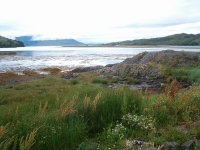
Fort William
Sitting on the shores of Loch Linnhe, Fort William is the gateway to some of the Highlands' finest natural attractions and is a natural stop-off for those heading up to the north of Scotland. Ben Nevis is just to the south of the town and at 4406ft (1,344m) is Britain's highest mountain. It is a very popular challenge for walkers, but should not be taken lightly. Although the mountain is not massive by international standards, the walk starts near sea level.
Climbers should also be prepared for the unpredictable Scottish weather that can quickly turn to sub-arctic temperatures at any time of year. The striking scenery of Aviemore, Cairngorm and Glencoe is nearby; in winter, the area opens for skiing for those happy to brave the regular blizzards. Fort William is also a good starting point for the West Highland Way, a footpath that runs along the West coast down to Glasgow. Another outdoor activity popular in the region is mountain biking, and there are some renowned downhill tracks near Fort William.
As the name suggests, Fort William also has a rather tumultuous military history.The town is now a peaceful summer holiday retreat that offers a selection of hotels, cafes, shops and restaurants.
The Highlands Climate and Weather
The climate in the Scottish Highlands is generally cool, damp and cloudy, but daily weather is unpredictable. The Highlands are prone to short winter days and very long summer evenings. January and February are the coldest months, averaging 37°F (3°C), and summer has average temperatures of 55°F (13°C) during its warmest months of July and August. Temperatures can be extreme in the Highlands, with a record winter low of -16°F (-27°C), and a record summer high of 87°F (31°C). There are significant variations in temperature according to altitude, with lower temperatures and more rain and snow on high ground. The Highlands have a rainy climate, with sporadic showers possible at any time of year, but autumn and winter are generally the wettest seasons. December is the gloomiest, darkest month, and May and June are the sunniest. Snow is possible between November and April.
The Scottish Highlands are at their prime between May and August and the best months to visit are May and June, which are the sunniest months, enjoying long daylight hours and less rain than the colder months on average.
United Kingdom travel info
Electricity
The electrical current in the UK is 240 volts, 50Hz. Flat, three-pin plugs are standard.
Language
English is the official language, though visitors will be astonished by the variety of regional accents.
Money
The currency is the British pound (GBP), which is divided into 100 pence. ATMs are available in almost all towns and Visa, MasterCard and American Express are widely accepted. Foreign currency can be exchanged at bureaux de change and large hotels, though better exchange rates are likely to be found at banks.
Tipping
Tips of 10 to 15 percent are expected in restaurants and upmarket hotels in the UK if a service charge hasn't been included. Hotel service staff receive an optional amount, while taxi drivers are usually given 10 to 15 percent of the fare. Tipping bartenders isn't expected, and tipping for other services is discretionary.
Health
There are no specific health risks associated with travel to the UK and food and water can be considered safe. The British National Health Service is excellent, and a number of countries have reciprocal health agreements with the UK including Australia, New Zealand and EU countries. Visitors from other countries such as Canada, South Africa and the United States are advised to take out comprehensive travel insurance.
Safety
It's generally safe to travel throughout the UK.
Local customs
Handshaking is customary when introduced to someone new. Smoking is banned in all enclosed public spaces, including pubs, restaurants and public transport. Queue barging is frowned upon and there is strict etiquette on escalators: stand on the right, walk on the left. Visitors may find Londoners more rushed and less friendly than locals in other parts of the country, particularly on London transport, where tourists are often the only people who talk.
Doing business
The four countries of the United Kingdom, although culturally and historically different, generally keep to the same business practices. Politeness and punctuality are key to good business relations and initial meetings are often conducted formally and impersonally, becoming more open and social as things progress. Business cards are exchanged at introductions, and dress is formal with dark suits preferred. Business hours are generally 8am to 5pm Monday to Friday with an hour taken at lunch.
The communication style can be difficult to adjust to: the British people respect politeness to a point that often obscures their ability to say exactly what they mean. As a result, travelling business people may need to learn to 'read between the lines' and to take cues from tone of voice and facial expression. Humour is also an integral part of the British system of communication, and is used to diffuse a tense situation and to cultivate relationships. Foreigners should never assume that an attempt at humour undermines a person's ability to do their job, or discredits the importance they attach to a deal or negotiation. Furthermore, they shouldn't be fooled into thinking that the British propensity for irony and sarcasm equates with an informal work environment.
Foreigners should be tactful during meetings, avoid becoming emotional and illustrate their experience with the subject at hand. Performance and initiative are looked upon favourably, whereas academic pretension is given far less credence. Meetings are often used as platforms for debate, rather than moments of confirmation, so there should be no surprise if not much progress is made. Foreigners should be sure to respect and appeal to all parties involved, as the British have recently begun to take a far flatter approach to management and the responsibility of decision-making. And if things go well, it's worth purchasing a pint or two for clients or colleagues; though gifts are borderline inappropriate, a round of drinks will rarely be refused.
Duty free
Travellers can bring the following goods into the UK tax or duty free: 200 cigarettes, 100 cigarillos, 50 cigars or 250g of tobacco, 18 litres of still table wine, 42 litres of beer, 4 litres of spirits or strong liqueurs or 9 litres of fortified wine, sparkling wine or other alcoholic beverages of less than 22 per cent volume.
Communications
The international country dialling code for the UK is +44. Mobile phone coverage is extensive and free WiFi is widely available in pubs and coffee shops. Travellers can purchase local prepaid SIM cards for unlocked phones or use eSIMs if their cellular providers support it on their networks.
Passport & Visa
If a visa is not required, travellers should hold a return or onward ticket, and proof of funds for the duration of stay. Passports must be valid for the period of intended stay in the UK. It's highly recommended that travellers' passports have at least six months' validity remaining after the intended date of departure from their travel destination. Immigration officials often apply different rules to those stated by travel agents and official sources. For visitors who are visa exempt up to a maximum stay of six months, the period of stay will be determined by the Immigration Officer on arrival.
Entry requirements
US travellers must hold a passport that is valid for the duration of their stay; a visa is not required for stays of up to six months.
Canadian passports must be valid for at least the expected duration of the stay. No visa is required for stays of six months or less.
Australian passports must be valid for at least six months after the departure date. No visa is required for stays of six months or less.
South Africans require a valid passport and a visa for entry or transit through the UK. South African temporary passports are not recognised.
Under the Common Travel Area agreement, citizens from the UK and Ireland are not required to pass through passport control. They can travel between both countries without a valid passport if they can prove they are a valid UK or Irish national.
New Zealand nationals must hold a valid passport, but no visa is required for stays of up to six months.
Useful contacts
United Kingdom Tourism Website: www.visitbritain.com
999 (General)Embassies / consulates in other countries
British Embassy, Washington DC, United States: +1 202 588 6500.
British High Commission, Ottawa, Canada: +1 613 237 1530.
British High Commission, Canberra, Australia: +61 2 6270 6666.
British High Commission, Pretoria, South Africa: +27 12 421 7500.
British Embassy, Dublin, Ireland: +353 1 205 3700.
British High Commission, Wellington, New Zealand: +64 4 924 2888.
Embassies / consulates in United Kingdom
United States Embassy, London: +44 20 7499 9000.
Canadian High Commission, London: +44 20 7004 6000.
Australian High Commission, London: +44 20 7379 4334.
South African High Commission, London: +44 20 7451 7299.
Irish Embassy, London: +44 20 7235 2171.
New Zealand High Commission, London: +44 20 7930 8422.


